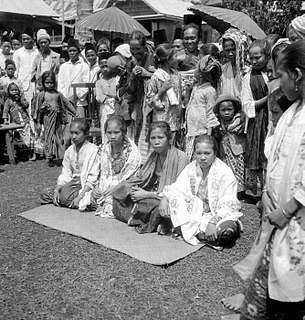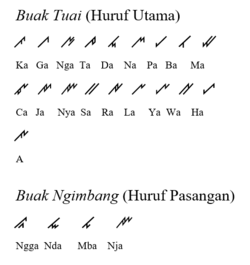
Unicode, formally The Unicode Standard is an information technology standard for the consistent encoding, representation, and handling of text expressed in most of the world's writing systems. The standard, which is maintained by the Unicode Consortium, defines 144,697 characters covering 159 modern and historic scripts, as well as symbols, emoji, and non-visual control and formatting codes.

The Brahmic scripts, also known as Indic scripts, are a family of abugida writing systems. They are used throughout the Indian subcontinent, Southeast Asia and parts of East Asia. They are descended from the Brahmi script of ancient India and are used by various languages in several language families in South, East and Southeast Asia: Indo-Aryan, Dravidian, Tibeto-Burman, Mongolic, Austroasiatic, Austronesian, and Tai. They were also the source of the dictionary order (gojūon) of Japanese kana.
Baybayin is a Philippine script. The script is an alphasyllabary belonging to the family of the Brahmic scripts. Geographically, it was widely used in Luzon and other parts of the Philippines prior to and during the 16th and 17th centuries before being replaced by the Latin alphabet during the period of Spanish colonization. It was used in the Tagalog language and, to a lesser extent, Kapampangan-speaking areas; its use spread to Ilokanos in the early 17th century. In the 19th and 20th centuries, baybayin survived and evolved into multiple forms—the Tagbanwa script of Palawan, and the Hanuno'o and Buhid scripts of Mindoro—and was used to create the constructed modern Kulitan script of the Kapampangan and the Ibalnan script of the Palawan tribe. Under the Unicode Standard and ISO 15924, the script is encoded as the Tagalog block.
The Balinese script, natively known as Aksara Bali and Hanacaraka, is an abugida used in the island of Bali, Indonesia, commonly for writing the Austronesian Balinese language, Old Javanese, and the liturgical language Sanskrit. With some modifications, the script is also used to write the Sasak language, used in the neighboring island of Lombok. The script is a descendant of the Brahmi script, and so has many similarities with the modern scripts of South and Southeast Asia. The Balinese script, along with the Javanese script, is considered the most elaborate and ornate among Brahmic scripts of Southeast Asia.
The Batak script is a writing system used to write the Austronesian Batak languages spoken by several million people on the Indonesian island of Sumatra. The script may be derived from the Kawi and Pallava script, ultimately derived from the Brahmi script of India, or from the hypothetical Proto-Sumatran script influenced by Pallava.

The Tamil script is an abugida script that is used by Tamils and Tamil speakers in India, Sri Lanka, Malaysia, Singapore, Indonesia and elsewhere to write the Tamil language. Certain minority languages such as Saurashtra, Badaga, Irula and Paniya are also written in the Tamil script.
Rejang or Rejangese may refer to:

Nepalese scripts are alphabetic writing systems employed historically in Nepal Mandala by the indigenous Newars for primarily writing Nepal Bhasa. It is also used for transcribing Sanskrit and Pali. There are also some claims they have also been used to write the Parbatiya (Khas) language.

Lubuklinggau, is a city in South Sumatra, Indonesia. It has an area of 419.80 km² and had a population of 201,308 at the 2010 Census and 234,166 at the 2020 Census. The city was formerly part of the Musi Rawas Regency from which it was separated in 2001.
The Lontara script, also known as the Bugis script, Bugis-Makassar script, or Urupu Sulapa’ Eppa’ "four-cornered letters", is one of Indonesia's traditional scripts developed in the South Sulawesi region. The script is primarily used to write the Buginese language, followed by Makassarese and Mandar. Closely related variants of Lontara are also used to write several languages outside of Sulawesi such as Bima, Ende, and Sumbawa. The script was actively used by several South Sulawesi societies for day-to-day and literary texts from at least mid-15th Century CE until the mid-20th Century CE, before its function was gradually supplanted by the Latin alphabet. Today the script is taught in South Sulawesi Province as part of the local curriculum, but with very limited usage in everyday life.
Bengkulu or Bengkulu Malay is a Malayic language spoken on the Indonesian island of Sumatra, around the city of Bengkulu. It is more closely related to other Malay variants in Sumatra such as Col, Jambi Malay and Palembang Malay as well Minangkabau spoken in neighbouring West Sumatra than to the Rejang language, which is also spoken in the province.
Standard Sundanese script is a writing system which is used by the Sundanese people. It is built based on Old Sundanese script which was used by the ancient Sundanese between the 14th and 18th centuries. Currently the standard Sundanese script is also commonly referred to as the Sundanese script.

Rencong is any native writing system found in central and south Sumatra, including Kerinci, Bengkulu, Palembang and Lampung. These scripts lasted until the 18th century, when the Dutch colonized Indonesia. These scripts were used to write manuscripts in native languages and in Malay, such as the Tanjung Tanah Code of Law. The Malay writing was gradually replaced by the Jawi script, a localized version of the Arabic script.

Pegon is a modified Arabic script used to write the Javanese, Sundanese, and Madurese languages, as an alternative to the Latin script or the Javanese script and the old Sundanese script. In particular, it was used for religious (Islamic) writing and poetry from the fifteenth century, particularly in writing commentaries of the Qur'an. Pegon includes symbols for sounds that are not present in Modern Standard Arabic. Pegon has been studied far less than its Jawi counterpart which is used for Malay, Acehnese and Minangkabau.

The Lampung or Lampungese are an indigenous ethnic group native to Lampung and some parts of South Sumatra, Bengkulu, as well as in the southwest coast of Banten. They speak the Lampung language, a Lampungic language estimated to have 1.5 million speakers.
Ga is the third consonant of Indic abugidas. In modern Indic scripts, ga is derived from the early "Ashoka" Brahmi letter , which is probably derived from the Aramaic letter after having gone through the Gupta letter .
Ṅa is the fifth consonant of Indic abugidas. In modern Indic scripts, It is derived from the early "Ashoka" Brahmi letter after having gone through the Gupta letter .

Rejang people are an Austronesian ethnolinguistic group, native to the some parts of Bengkulu Province and South Sumatera Province in the southwestern part of Sumatera Island, Indonesia. They occupied some area in a cool mountain slopes of the Barisan mountain range in both sides of Bengkulu and South Sumatra. With approximately more than 1,3 million people, they form the largest ethnic group in Bengkulu Province. Rejang people predominantly live as a majority in 5 out 10 regencies and city of Bengkulu Province, while the rest of them who lives in South Sumatera resides at 7 villages in the district called as Bermani Ulu Rawas. The Rejangs are predominantly an Islam adherent group with small numbers following a religion other than Islam. According to research, Rejang people are the descendants of the Bukar-Sadong people who migrated from Northern Borneo (Sarawak).
Rejang is an Austronesian language predominantly spoken by the Rejang people in southwestern parts of Sumatra (Bengkulu), Indonesia. There are five dialects, spread from mountainous region to the coastal region of Bengkulu, including the Musi (Musai) dialect, the Lebong dialect, the Kebanagung dialect, the Rawas (Awes) dialect, and the Pesisir dialect.
Lembak people, also known as Linggau people, are a local ethnic group that inhabits several areas of Bengkulu Province and South Sumatra Province in Indonesia. Their original settlements are in the border area between the two provinces, in the Barisan mountain range, with densely clustered villages pattern.










